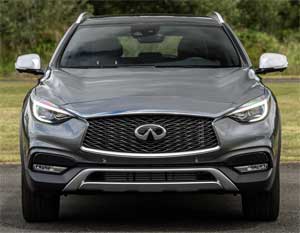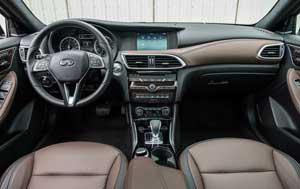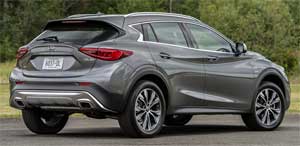2017 Infiniti QX30
It looks like the lines between hatchback “car” and crossover “utility vehicle” have finally been obliterated entirely. As proof we present the Infiniti QX30, the latest addition to the growing compact luxury CUV market here in the U.S., but basically the same vehicle is also known as the Q30 hatchback in Europe. And that’s just the beginning of the blurred lines for this this dynamic little 5-door hatchback…sorry…crossover.
Yes, this 2017 Infiniti QX30 is many things to many people. But what really matters here, is that it arrives at a perfect time; when Americans can’t seem to get enough small luxury crossovers.
Oh, and for those of you who have been bemoaning the fact that you can’t buy a Mercedes-Benz A-class hatchback here; well, now you can, because that’s what’s under the QX30’s way more dynamic bodywork.
Yes, this is the first vehicle to emerge from the Renault/Nissan/Daimler partnership announced last year. And though the overall stance and silhouette are very similar to the Mercedes-Benz GLA crossover; it’s much better looking, if you speak Infiniti’s design language like we do, we’d pick this one over the GLA.
 There’s a decent 8.0-inches of ground clearance, same as the GLA. Unless of course you opt for front-wheel-drive only Sport trim. Which to confuse things further, really is the Q30 also known as the A-Class hatchback, with its hard parts just 6.1–inches above the pavement. It also comes with some minor unique exterior elements.
There’s a decent 8.0-inches of ground clearance, same as the GLA. Unless of course you opt for front-wheel-drive only Sport trim. Which to confuse things further, really is the Q30 also known as the A-Class hatchback, with its hard parts just 6.1–inches above the pavement. It also comes with some minor unique exterior elements.
Infiniti engineers had their way with the suspension of course, so it rides nothing like the GLA. It felt stiffer initially, but better the more time we spent with it; no suspension altering drive modes to be found here.
It drives lively, not economy car-like at all; straddling the comfort/capability line almost perfectly. Leaning slightly more towards the tougher end than some other “sporty crossovers”, which is no longer a weird thing to say. Yet it remains exceptionally quiet.
There’s good pick-up from the standard 2.0-liter turbo I4 and 7-speed DCT transmission, both of which come from Mercedes; as does the key to get things started. Software for managing all of it, however, comes from Nissan, still the overall feel is very Benz, and ratings are the same at 208-horsepower and 258 lb-ft. of torque.
The Intelligent all-wheel-drive system is also a version of Benz’s 4MATIC, which can send as much as 50% of torque to the rear wheels when slip is detected.
There was noticeable turbo-lag, and an overall softer launch than when we had the GLA, but the resulting 0-60 time was still not bad at 6.8-seconds.
 As is usually the case, if you’re looking for the best outcome, just leave it in auto, as manual shifting was slow to respond. Still, there was a nice whoosh of sound coming from the turbo-4 as it powered us to the end of the ¼-mile in 15.1-seconds at 92 miles-per-hour.
As is usually the case, if you’re looking for the best outcome, just leave it in auto, as manual shifting was slow to respond. Still, there was a nice whoosh of sound coming from the turbo-4 as it powered us to the end of the ¼-mile in 15.1-seconds at 92 miles-per-hour.
Through the cones, there’s a playful nature; with minimal amounts of both under and oversteer. Suspension feels taut, and it remained very flat.
Infiniti also tweaked the steering to their liking, but they did it no favors as far as we’re concerned. It’s loose feeling on-center, and there’s an awkward heft when making inputs.
A 110-foot stopping average from 60 is very good, and stops were both smooth and stable. But after about 4-runs, fatigue set in and brakes started to fade.
Inside the QX30’s cabin is where things depart most from its Mercedes-Benz roots. There are still some GLA controls on the dash, but things appear much more inviting. Material quality is quite good.
Infiniti owners who aren’t familiar with the GLA will enjoy the refreshing new take on layout, as well as find the fit-and finish they are used to. The most obvious Benz element is the door mounted seat control; but they work so well, we’re glad Infiniti left them alone.
Both central controller and shifter are unique, with a nice obvious Park button.
 There’s a comfortable seating position for the driver; but visibility is very poor, with thick pillars in back as well as a very small rear window.
There’s a comfortable seating position for the driver; but visibility is very poor, with thick pillars in back as well as a very small rear window.
Government Fuel Economy Ratings for all-wheel-drive are 21-City, 30-Highway, and 25-Combined; so our 30.7 miles-per-gallon of Premium average was excellent.
Still there’s only an average Energy Impact Score of 13.2-barrels of annual oil consumption with CO2 emissions of 6.0-tons.
With many different QX30s to choose from, $30,945 to start seems reasonable, considering it’s about 2-grand cheaper than a GLA.
So, while the Mercedes-Benz GLA came to market earlier, don’t think of this 2017 Infiniti QX30 as a re-badged Benz, but a cooperative effort along the lines of Toyota and Subaru with the 86 and BRZ. It is highly competitive with the current influx of cute utes, as well as a perfect step up for open-minded hatchback buyers. We predict this international coalition will be quite successful.
Specifications
- Engine: 2.0 liter
- Horsepower: 208
- Torque: 258 lb-ft.
- 0-60 mph: 6.8 seconds
- 1/4 mile: 15.1 seconds @ 92 mph
- EPA: 21 mpg city / 30 mpg highway
- Energy Impact: 13.2 barrels of oil/yr
- CO2 Emissions: 6.0 tons/yr
2024 Polestar 2
More Range And More Power For The Polestar 2
Volvo is well on their way to making the transition to an all-electric brand, but their sister-brand Polestar is already there. Now, we’ve spent lots of time in their all-wheel drive, five-door Polestar 2, having tested it in 2021, and a year later when a two-wheel drive version arrived. But, EV updates are coming quickly. So, let us be your guide for all that’s new with the Polestar 2.
While we are driving more EVs than ever, we’ve also been spending a lot of time recently circling back to ones we’ve previously tested. As in this new era of electrified vehicles, significant updates are arriving quickly, with R&D investments increasing and retrofitting them easier than ever. This is often done through software updates that can even be accomplished over the air. For 2024, the Polestar 2 has indeed gotten some software updates, but some physical ones as well.
Clearly aimed directly at Tesla’s Model 3 when it arrived; the Polestar 2’s build quality was vastly better, but range definitely came up short. So, addressing that was priority No. 1; and for ’24 the Polestar can travel up to 20% farther than before while consuming 9% less energy, and when it comes time to charge it back up, it can do that 34% faster too.
Range in the Single Motor version increases from a max of 270 to 320 miles thanks to a larger 82-kWh battery pack, and that solitary motor now powers the rear wheels, not the front wheels. It’s also bigger, coming in at 220 kW compared to the previous 170 kW front-wheel drive version, going from 231 to 299 horsepower.
Dual Motors keep the same 78-kWh battery, but still sees a boost from 260 to 276 miles and takes advantage of the larger rear motor for a new combined 310-kW output with 421 horsepower. Our test car has the added Performance Pack, which uses an additional 35 kW to deliver 455 horsepower and 546 lb-ft of torque, though max range drops to just 247 miles.
The new battery in rear-drive 2s will also charge faster, now accepting up to 205 kW for an 80% charge in 20 minutes; max for dual-motors stays at 155 kW, which puts an 80% charge at 34 minutes. Using 32 kWh of electricity per 100 miles, the Dual Motor earns a good efficiency rating.
The [Polestar] 2 has always been one of the most enjoyable EVs to drive, even more so now with that additional power coming from the rear motor.
Unfortunately, extremely cold temperatures kept us from seeing that increased range, as we were only on pace for about 194 miles in our test.
The 2 has always been one of the most enjoyable EVs to drive, even more so now with that additional power coming from the rear motor. And especially when equipped with the Performance Pack as it not only includes more power, but adds 20-inch forged wheels, upgraded brakes, and adjustable Ohlins Dual Flow Valve performance dampers. It greatly improves handling prowess without affecting ride quality, and is easily worth the $5,500 charge if you at all enjoy driving.
Even on a 20-degree track day there was plenty of grip through our handling course. No understeer or oversteer, and lots of feedback through the wheel. There was a nice, strong launch off the line that properly planted us firmly in the seat, and rocketed us to 60 in 4.5 seconds. Power delivery stayed pretty intense up until about 80 mph when there was a definite tapering off. Still, it was a 13.4-second quarter-mile at 102 mph; smooth, quiet, and stable the whole way.
When this car debuted, its Google-based infotainment setup was a novelty, but since then, more and more manufacturers are just “Googling it” so it doesn’t seem out of place at all. The wireless phone charger is easy to access, and there’s a great Harmon/Kardon sound system and panoramic sunroof to enhance the in-cabin experience. Exteriors have also been enhanced with a smooth grille insert and new wheel choices.
Hatchback practicality means 14.3 cu-ft of easy to access cargo space with split-folding seatbacks for longer items and expanding the space to 38.7 cu-ft. Plus, there’s even a sizeable storage bin up front under the hood.
Single Motor Polestar 2 pricing now starts at $51,300, with Dual Motors starting at $56,700; topping out at $64,400.
For a car manufacturer that hasn’t even been around for a decade yet, Polestar has kept itself busy, totally transforming their latest model in just a few years, making the 2024 Polestar 2 even more appealing. They are certainly off to a good start, and with a host of Polestars just over the horizon, including some all-important utility vehicles, this star will be shining even brighter.
Specifications
As Tested
- Motor Setup: Dual Motor
- Horsepower: 455
- 0-60 mph: 4.5 seconds
- EPA Range: 247 miles
- Efficiency : 32 kWh / 100 miles
- Battery Size: 78-kWh
- Torque: 546 lb-ft
- 1/4 Mile: 13.4 seconds at 102 mph
- MW Test Loop: ~ 194 miles
- Peak Charging Rate: 155 kW











































